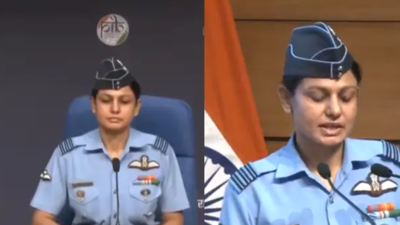NEW DELHI: Wing Commander Vyomika Singh, a decorated helicopter pilot with the Indian Air Force, on Wednesday jointly led the high-profile media briefing on ‘Operation Sindoor‘, India’s retaliatory strike on terror camps in Pakistan and PoK, following the massacre of 26 civilians in Jammu & Kashmir’s Pahalgam on April 22, 2025.She was joined by Colonel Sophia Qureshi of the Indian Army during the first official press conference on the operation.
Operation Sindoor
The two officers, representing the IAF and the Army, outlined the objectives and outcomes of the strike.
From sixth-grade dream to frontline duty
Vyomika Singh’s journey to the Indian Air Force began early. Inspired by the skies since her school days, her name itself — Vyomika, meaning “the one who resides in the sky”, seemed to script her destiny. A engineering graduate, she became the first in her family to join the armed forces and was commissioned into the IAF as a helicopter pilot.
Pilot with 2,500+ flying hours in hostile terrain
Wing Commander Singh has logged over 2,500 flying hours, piloting aircraft like the Chetak and Cheetah across some of India’s most hostile terrains, including Jammu & Kashmir and the Northeast. In November 2020, she led a key rescue mission in Arunachal Pradesh, navigating through harsh weather and high altitudes.
High-altitude endurance missions
In 2021, Singh was part of a tri-services all-women expedition to Mt Manirang, a 21,650-feet Himalayan peak. Her participation in such missions has been recognised by senior defence leadership and reflects the growing leadership roles being taken up by women in the Indian military.‘Operation Sindoor’ strikes nine terror camps across PoK, Pakistan in response to Pahalgam attackIn a response to the terror attack in Pahalgam, the Indian Armed Forces carried out pre-dawn strikes on Wednesday under ‘Operation Sindoor’, targeting and destroying nine terror hideouts deep inside Pakistan and Pakistan-occupied Kashmir (PoK). Briefing the media alongside Foreign Secretary Vikram Misri and Col Sofiya Qureshi, Wing Commander Vyomika Singh said the operation was designed to ensure justice for the victims of the Pahalgam massacre and their families. “Nine terrorist camps were targeted and successfully destroyed. All locations were carefully chosen to prevent any civilian casualties or damage to civilian infrastructure,” she said. Col Sofiya Qureshi presented video evidence of the strikes, confirming that the targeted camps included those at Muridke—where 26/11 attackers David Headley and Ajmal Kasab were trained—along with the Sarjal camp in Sialkot, Markaz Ahle Hadith, Barnala, Markaz Abbas in Kotli, and Mehmoona Joya camp in Sialkot.Pahalgam attack aimed to derail peace: Foreign Secy Foreign Secretary Vikram Misri described the Pahalgam attack as an act of deliberate brutality intended to disrupt the return of peace to Jammu and Kashmir. “The victims were shot at close range, often in front of their families, who were deliberately traumatised. The objective was to send a message and destabilise normalcy in the region,” he said. Misri added that Indian intelligence agencies had credible inputs indicating further terror plots. “Our intelligence suggested more attacks were being planned. India had both the compulsion and the right to act. This morning’s response was calibrated, proportionate, and intended to prevent future cross-border terror threats,” he said.

